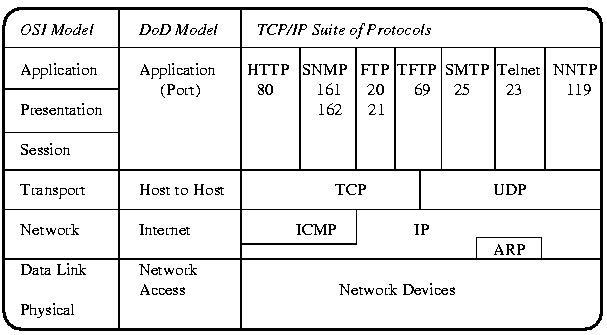| Introduction to Data Communications | ||
|---|---|---|
|
|
53. The Suite of TCP/IP Protocols | Next |

OSI Model and the DoD Model of TCP/IP
It is not a perfect matching between the OSI Model and the DoD model, it is close enough in principle. Note: Only a few of the major Application layer protocols are displayed, a complete listing is presented in Appendix I: TCP/IP Well Known Ports.
Network Devices are network interface cards (NIC) and their software drivers. Typically, they are Ethernet cards, Token Ring cards, WAN links such as ISDN or Frame Relay and they can also be modems and serial ports. The most common protocol used is Ethernet which uses an address burned into the NIC to identify itself to the local network. A typical Ethernet MAC (media access control) address is a 48 bit number and would look like 00-02-AF-97-F2-03. Note: the MAC address is always represented by hexadecimal numbers.
IP stands for Internet Protocol and its main job is to find the best route through the Internet to the destination. IP uses IP addresses to identify the host machine and the network. A typical IP address is a 32 bit number and looks like 142.110.237.1 where in this case 142.110.237.0 identifies the network address and 0.0.0.1 identifies the host machine. IP addresses are always represented by decimal numbers. IP protocol data units (PDUs) are called datagrams and provide a connectionless service (send and pray).
ARP stands for Address Resolution Protocol and it is used to map IP addresses to MAC addresses. This is needed because the Network layer is not aware of the Data Link layer's addresses and vice versa.
ICMP stands for Internet Control Message Protocol and is used mainly for troubleshooting TCP/IP network connections. Two common programs, ping and traceroute, are part of ICMP.
TCP stands for Transmission Control Protocol and is used to guarantee end to end delivery of segments of data, to put out of order segments in order and to check for transmission errors. TCP is a connection-oriented service.
UDP stands for User Datagram Protocol and is a connectionless service. This results in a low overhead, fast transfer service that relies on the upper layer protocols to provide error checking and delivery of data.
In the Application layer lies many hundreds of network aware programs and services such as:
HTTP (80) - HyperText Transport Protocol which is used for transferring webpages. SNMP (161/162) - Simple Network Management Protocol which is used for managing network devices. FTP (20/21) - File Transfer Protocol which is used for transferring files across the network. TFTP (69) - Trivial File Transfer Protocol which is a low overhead fast transfer FTP protocol. SMTP (25) - Simple Mail Tranfer Protocol which is used for transferring email across the Internet. Telnet (23) - An application for remotely logging into a server across the network. NNTP (119) - Network News Transfer Protocol which is used for transferring news.
The numbers, shown in brackets next to the protocols, are called the Well Known Port Numbers, TCP and UDP use these port numbers to indicate where the segments should be sent to. For example, webservers use Port 80 to indicate that the HTTP protocol is used. A Socket is another name for a Well Known Port. A complete listing of the ports is presented in Appendix I: TCP/IP Well Known Ports.
| Introduction to Data Communications | ||
|---|---|---|
|
|
Table of Contents | Next |